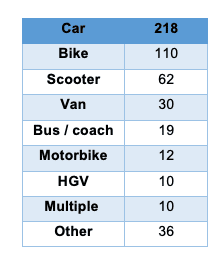Ubique
Member
- Messages
- 2,287
- Location
- East Midlands
Not any more!We've only got 6 EVs


Not any more!We've only got 6 EVs



The link I posted above does, if you can be bothered to scroll down, give a nice pie chart of vehicle type.A kid's battery scooter which has never been test against any recognized standard counts as a "vehicle" in this case. It would be helpful if figures could be differentiated between 2 and 4 wheel vehicles and and also malicious or accidental fires.

CTSI issues warning about e-bike and e-scooter battery fires
www.tradingstandards.uk
I read that. I don't think you read the preceding paragraphThe link I posted above does, if you can be bothered to scroll down, give a nice pie chart of vehicle type.
For those with limited attention span, here it is. (although it should be titled Percentage of fires by vehicle type).
View attachment 405602

My company H&S rules stipulate that no BEV's are to be charged in the workshops, now I'm not privvy to their thinking or research prior to taking that decision, risk assessment is a main part of their remit though.
Are the figures based on numbers only? Perhaps (its logical) London EV's are not just far greater a percentage of vehicles than the median (given the ULEZ & incomes etc hardly a surprise), but also doing a lot more journeys, a lot more stop/start, and being charged more frequently than the median?@Ubique do you have any insights as to why electric cars in London are bursting into flames at a significantly greater rate than anywhere else in the UK? If it was a fundamental flaw with the vehicles I would expect to see similar percentages of vehicles compared to rest of country, the numbers may be higher but % I'd expect to be the same.
I suspect numbers of electric cars are higher in London due to congestion charging.@Ubique do you have any insights as to why electric cars in London are bursting into flames at a significantly greater rate than anywhere else in the UK? If it was a fundamental flaw with the vehicles I would expect to see similar percentages of vehicles compared to rest of country, the numbers may be higher but % I'd expect to be the same.
With regards to your companies risk assessment there are a number of hazards such as trailing leads, customers dodgy granny chargers, overloaded circuits, extension leads etc which could lead a H&S expert to implement a blanket ban on charging indoors in a large dealership.
Sorry but without the caviat of ,say, per 1000 vehicle type then the chart is meaningless. Or have I missed something?The link I posted above does, if you can be bothered to scroll down, give a nice pie chart of vehicle type.
For those with limited attention span, here it is. (although it should be titled Percentage of fires by vehicle type).
View attachment 405602
All sensible reasons.... but the profitability or efficient use of workspace aren't of concern to insurance Co. They assess Risk (& Consequence) & set their limits accordingly.I suspect numbers of electric cars are higher in London due to congestion charging.
Charging cars inside a commercial garage putting fire risk, trailing leads etc to one side….while the car is charging, your not working in it, so you in effect have non productive floor space with an overhead cost, makes complete sense to charge it outside in cheaper space and use inside side space to produce revenue.
No one mentioned insurance companies, only you…it was stated to be against their h&s policy, nothing to do with insurance.All sensible reasons.... but the profitability or efficient use of workspace aren't of concern to insurance Co. They assess Risk (& Consequence) & set their limits accordingly.
Who did the research (& esp. who funded it) are extremely important factors in any "Findings".There was other research done that showed that the chance of a fire in an ev is actually significantly lower than an ice, with a hybrid being worst of all. I linked to it in an earlier post but I’m not going back to dig it out.
This was over a number of cars (i.e number of fires per 100,000 vehicles) so not simply figures that without any context are meaningless.
@Ubique do you have any insights as to why electric cars in London are bursting into flames at a significantly greater rate than anywhere else in the UK? If it was a fundamental flaw with the vehicles I would expect to see similar percentages of vehicles compared to rest of country, the numbers may be higher but % I'd expect to be the same.
With regards to your companies risk assessment there are a number of hazards such as trailing leads, customers dodgy granny chargers, overloaded circuits, extension leads etc which could lead a H&S expert to implement a blanket ban on charging indoors in a large dealership.
OK. Does that mean it's not a valid decision/policy, and without sound reasons / grounds?No one mentioned insurance companies, only you…it was stated to be against their h&s policy, nothing to do with insurance.
No, it just means you are reading things into it without knowing the full context, and insinuating it's an insurance issue when it isn't (Or rather might not be, we just don't know). Nothing more.OK. Does that mean it's not a valid decision/policy, and without sound reasons / grounds?




